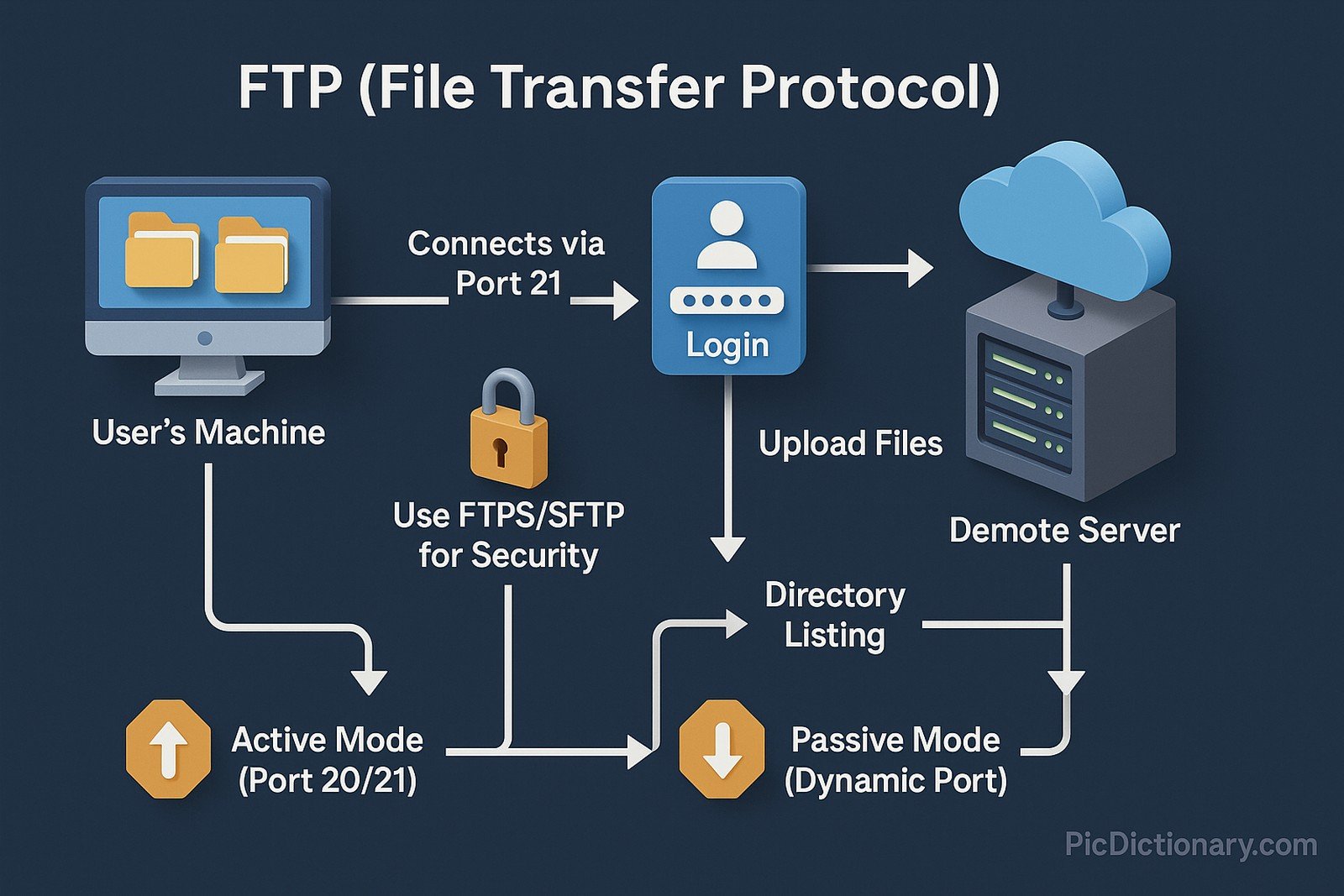FTP (File Transfer Protocol)
 (Representational Image | Source: Dall-E)
(Representational Image | Source: Dall-E)
Quick Navigation:
- FTP (File Transfer Protocol) Definition
- FTP (File Transfer Protocol) Explained Easy
- FTP (File Transfer Protocol) Origin
- FTP (File Transfer Protocol) Etymology
- FTP (File Transfer Protocol) Usage Trends
- FTP (File Transfer Protocol) Usage
- FTP (File Transfer Protocol) Examples in Context
- FTP (File Transfer Protocol) FAQ
- FTP (File Transfer Protocol) Related Words
FTP (File Transfer Protocol) Definition
FTP (File Transfer Protocol) is a standard network protocol used to transfer files between a client and a server over a TCP/IP network. It enables the upload and download of files, directory listings, and file management across remote systems. FTP operates in active and passive modes, utilizing ports 20 and 21. It supports authentication via usernames and passwords, although modern security enhancements recommend using FTPS or SFTP for encrypted transmission. FTP has been pivotal in website management, software updates, and data sharing between systems since the early days of the internet.
FTP (File Transfer Protocol) Explained Easy
Imagine you have a big box of toys at your friend’s house. FTP is like a magical delivery truck that lets you send toys (files) back and forth between your house and your friend’s house. You can tell the truck to bring toys from your friend’s place to you or send your toys to your friend’s place. It’s fast, reliable, and keeps track of all your stuff.
FTP (File Transfer Protocol) Origin
FTP was first introduced in the early 1970s by Abhay Bhushan, as part of the ARPANET project. The protocol was developed to allow researchers and computer scientists to share and transfer files remotely. Over time, FTP evolved through various RFC (Request for Comments) documents, becoming a key part of internet-based file exchange.
FTP (File Transfer Protocol) Etymology
The name originates from the combination of “file transfer” and “protocol,” describing its purpose as a set of rules for transferring files across systems.
FTP (File Transfer Protocol) Usage Trends
Although FTP usage has declined in consumer environments due to cloud-based services, it remains prevalent in enterprise IT, web development, and legacy systems. FTP servers are still used for website deployment, automated data backup, and file exchange between business partners. Secure versions like FTPS and SFTP have gained popularity, replacing plain FTP where security is a concern.
FTP (File Transfer Protocol) Usage
- Formal/Technical Tagging:
- Network Protocols
- Data Transfer
- Web Hosting - Typical Collocations:
- "FTP server"
- "FTP client"
- "upload via FTP"
- "secure FTP connection"
FTP (File Transfer Protocol) Examples in Context
- Website developers upload site files to web servers using FTP clients.
- Companies use FTP servers to distribute large software updates.
- Automated backup systems transfer data nightly via FTP to remote servers.
FTP (File Transfer Protocol) FAQ
- What is FTP used for?
FTP is used to transfer files between computers over a network. - Is FTP secure?
By itself, FTP is not secure; secure alternatives like FTPS or SFTP are recommended. - What’s the difference between FTP and SFTP?
SFTP is FTP over SSH, providing encrypted communication, while FTP does not offer encryption. - Can I use FTP in modern web browsers?
Most browsers have discontinued FTP support; standalone FTP clients are recommended. - What ports does FTP use?
FTP uses ports 20 (data transfer) and 21 (control connection). - How do I log in to an FTP server?
You typically log in using a username and password, or sometimes anonymously. - What are active and passive FTP modes?
Active mode connects from the client to the server, and the server back to the client; passive mode has the client initiate both connections for firewall compatibility. - What’s the role of FTP in website development?
FTP is commonly used to upload and manage website files on web servers. - Can FTP transfer large files?
Yes, FTP can handle large file transfers, but interruptions may require restarting transfers unless supported by resume features. - Is FTP still relevant today?
Yes, it’s widely used in enterprise environments and automated data workflows, though often with added security layers.

FTP (File Transfer Protocol) Related Words
- Categories/Topics:
- Network Protocols
- Data Transmission
- Web Development
Did you know?
NASA once used FTP servers extensively to share satellite imagery and data with researchers worldwide, enabling rapid scientific collaboration across continents before cloud systems became mainstream.
PicDictionary.com is an online dictionary in pictures. If you have questions or suggestions, please reach out to us on WhatsApp or Twitter.Authors | Arjun Vishnu | @ArjunAndVishnu

I am Vishnu. I like AI, Linux, Single Board Computers, and Cloud Computing. I create the web & video content, and I also write for popular websites.
My younger brother, Arjun handles image & video editing. Together, we run a YouTube Channel that's focused on reviewing gadgets and explaining technology.



Comments powered by CComment